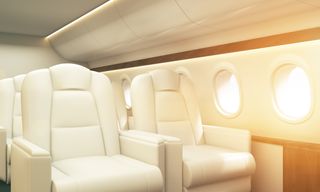Airing of Grievances: First-Class Cabins Raise 'Air Rage' Risks

You've seen the headlines about airline passengers losing their cool on flights, but is there a reason behind these mile-high rages? A new study says yes, but the reason may not be shrinking seats or crowded cabins.
Rather, the presence of a first-class cabin — and whether all passengers need to walk through it when boarding, to get to their own seats — may be playing a role in these incidents of "air rage," according to the study, published today (May 2) in the journal Proceedings of the National Academy of Sciences.
"The modern airplane reflects a social microcosm of class-based society," the study authors — Katherine DeCelles, an associate professor of organizational behavior at the University of Toronto, and Michael Norton, a professor of business administration at Harvard Business School in Massachusetts — wrote in their study. [Understanding the 10 Most Destructive Human Behaviors]
First-class cabins make passengers aware of inequality, and this increased awareness may lead to the aggressive behaviors that some people exhibit on airplanes, the investigators wrote in the study. Research has shown that a greater awareness of being disadvantaged may increase negative emotions and aggressive behaviors in people, the study said.
In the study, the researchers obtained a private database of all the disruptive incidents that occurred on a specific airline over several years (the study did not report which airline it was). The investigators then looked at a slew of information about the flights, including the size of the cabin, the size of the seats and if there were any delays. The researchers also looked into whether the plane had a first-class cabin, and whether the coach passengers had to walk through first class in order to get to their own seats.
The factor with the largest impact on air rage was whether coach passengers had to walk through first class, the researchers found. Air rage incidents were almost four times as likely on flights that had first-class seating compared to flights without such seating, an increase on par with what the researchers said would be expected if a flight was delayed for 9.5 hours.
When the researchers looked specifically at flights with first-class cabins, the data showed that where the passengers boarded the plane also had an effect. When passengers had to walk through the first-class cabin to get to their seats, for example, the risk of air rage was 2.2 times greater compared with when passengers could board directly into the coach cabin of the plane, or the equivalent of a nearly 6-hour delay, the study said.
Sign up for the Live Science daily newsletter now
Get the world’s most fascinating discoveries delivered straight to your inbox.
The research also showed that intoxication was involved in nearly 32 percent of all incidents, belligerent behavior accounted for 29 percent of incidents and noncompliance (not following a crewmember's instructions) accounted for 19 percent of incidents.
But a first-class ticket doesn't make a passenger immune to air rage — far from it, the researchers found. Instead, they discovered that for front-boarding planes, air rage incidents were nearly 12 times greater among first-class passengers compared with middle-boarding planes. [20 Startling Facts about American Society and Culture]
Indeed, previous research shows that when individuals of a higher social class look down on those of a lower social class, they're more likely to act in selfish, entitled and scornful ways, which may explain the frequency of air rage incidents in first-class cabins, the study said.
The researchers also found that where a passenger is seated may influence the type of air rage exhibited. For example, belligerent behavior was more common in first class compared to coach class, while emotional outbursts were more common in coach than in first class, the study said.
It should be noted that the data came from a single airline. Further research is needed to confirm the findings.
Follow Sara G. Miller on Twitter @saragmiller. Follow Live Science @livescience, Facebook & Google+. Originally published on Live Science.

Most Popular



